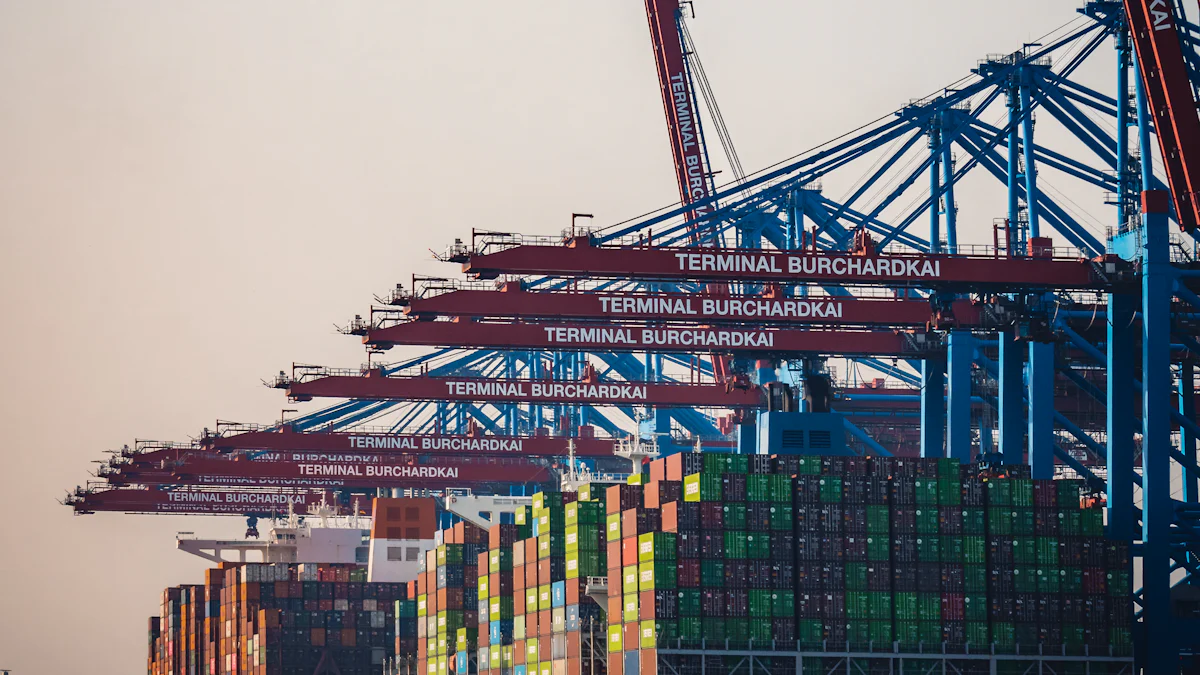Maritime market situation and future development trend 2025

The maritime market plays a vital role in global trade, moving over 80% of the world’s goods across oceans. As shipping demand grows, you face increasing pressure to reduce shipping costs while maintaining efficiency. Rising fuel prices and port congestion add to these challenges, making cost optimization essential for stakeholders like you. JUSDA emerges as a trusted partner, offering innovative supply chain solutions tailored to your needs. With its JusLink intelligent platform, JUSDA helps streamline ocean freight cargo operations, ensuring cost-effective and sustainable logistics for businesses worldwide.
Key Takeaways
The maritime market is crucial for global trade, with over 80% of goods transported by sea, highlighting the need for efficient logistics.
Adapting supply chain strategies post-pandemic is essential; consider diversifying routes and leveraging technology to enhance resilience.
Rising fuel prices and port congestion are significant challenges; explore alternative fuels and invest in automated systems to mitigate costs.
Emerging markets in Asia and Africa offer opportunities for cost reduction; tapping into these regions can optimize your shipping expenses. Sustainability is a growing priority; adopting eco-friendly practices not only benefits the environment but can also lead to cost savings.
Utilizing digital tools for route optimization and cargo tracking can significantly enhance operational efficiency and reduce shipping costs. Partnering with JUSDA and leveraging their JusLink platform can provide tailored solutions to streamline your logistics and manage costs effectively.
Current Maritime Market Overview

Key Trends in Ocean Freight Cargo
Growth in global trade and its impact on shipping demand
Global trade continues to expand, driving higher demand for ocean freight cargo.
Shifts in supply chain strategies post-pandemic
The pandemic reshaped global supply chains, forcing you to adapt to new challenges. Companies now prioritize shorter and more diverse supply chains to minimize risks. This shift reduces dependency on single regions and enhances resilience. Additionally, advancements in technology, such as autonomous shipping and digital tracking tools, help you streamline operations. These innovations improve efficiency and ensure timely delivery, even in unpredictable circumstances.
Challenges in Reducing Freight Costs
Rising fuel prices and their effect on shipping costs
Fuel prices remain a significant factor in determining shipping expenses. As fuel costs rise, you face higher operational expenses, which directly impact your ability to reduce freight costs. The maritime industry explores alternative energy sources, such as liquefied natural gas (LNG), to address this challenge. These efforts aim to lower fuel consumption and promote sustainability while helping you manage costs effectively.
Port congestion and delays in global shipping
Port congestion disrupts shipping schedules and increases costs. You may experience delays caused by overcrowded ports, labor shortages, or inefficient processes. These issues lead to longer transit times and higher storage fees. To combat this, many ports invest in advanced technologies like automated systems to improve cargo handling. Efficient port operations are essential for reducing delays and keeping shipping costs under control.
Opportunities for Cost Reduction
Expansion of emerging markets in Asia and Africa
Emerging markets in Asia and Africa present significant opportunities for cost reduction. These regions offer access to new trade routes and lower labor costs, enabling you to optimize shipping expenses.
Increasing demand for sustainable and efficient shipping solutions
Sustainability has become a priority for the maritime industry. You see a growing demand for eco-friendly shipping practices, such as using greener fuels and energy-efficient vessels. The International Maritime Organization (IMO) aims to reduce carbon emissions by 2030, encouraging you to adopt sustainable solutions. These initiatives not only benefit the environment but also help you reduce shipping costs by improving fuel efficiency and streamlining operations.
Key Factors Influencing the Market
Economic Factors Impacting Shipping Costs
Fluctuations in global trade volumes and GDP growth
Global trade volumes and GDP growth directly influence shipping costs. When trade volumes rise, you may notice increased demand for shipping services, which often leads to higher freight rates.
Impact of inflation and currency exchange rates on freight costs
Inflation and currency exchange rates play a significant role in determining freight costs. Inflation increases operational expenses, including labor and fuel costs, which can raise shipping rates. Currency exchange rate fluctuations also affect international trade, as they influence the cost of goods and services across borders. By monitoring these economic factors, you can identify opportunities to negotiate better rates with carriers and reduce freight costs.
Technological Advancements in Reducing Costs
Adoption of digital tools for route optimization and cargo tracking
Digital tools have revolutionized the maritime industry by enabling route optimization and real-time cargo tracking. These technologies help you identify the most efficient shipping routes, reducing fuel consumption and transit times. Maritime information systems, driven by the need for safety and compliance, further enhance operational efficiency. By adopting these tools, you can streamline your supply chain and reduce shipping costs while ensuring timely deliveries.
Development of autonomous shipping technologies
Autonomous shipping technologies are transforming the way goods are transported across oceans. These innovations, powered by machine learning and AI, improve operational efficiency and create a more resilient supply chain. Autonomous vessels reduce labor costs and minimize human errors, leading to safer and more cost-effective shipping. As these technologies continue to evolve, you can expect significant savings and enhanced reliability in maritime logistics.
Regulatory and Environmental Factors
IMO regulations on carbon emissions and their implications
The International Maritime Organization (IMO) has introduced strict regulations to reduce carbon emissions in the maritime industry. These rules encourage you to adopt greener practices, such as using low-sulfur fuels and energy-efficient vessels. While compliance may require initial investments, these measures ultimately help you reduce freight costs by improving fuel efficiency and minimizing environmental impact.
Push for greener fuels and energy-efficient vessels
The push for greener fuels, such as liquefied natural gas (LNG) and hydrogen, is reshaping the maritime industry. Energy-efficient vessels equipped with advanced technologies consume less fuel, reducing operational costs. By embracing sustainable practices, you not only contribute to environmental conservation but also enhance your competitiveness in the market. These efforts align with the growing demand for eco-friendly shipping solutions, helping you consolidate shipments and optimize costs.
Predictions for 2025

Technological Innovations in Ocean Freight Cargo
Increased use of AI and IoT in maritime logistics
By 2025, you will see AI and IoT technologies transforming maritime logistics.
Growth of blockchain for secure and transparent transactions
Blockchain technology will revolutionize how you manage maritime transactions. It will create a secure and transparent system for tracking shipments and verifying documents. Smart contracts will automate payment processes, reducing administrative tasks and errors. This technology will also improve traceability, allowing you to track goods from origin to destination with ease. By adopting blockchain, you can build trust with partners and customers while cutting costs associated with manual processes and fraud prevention.
Sustainability and Green Shipping
Adoption of alternative fuels like LNG and hydrogen
The maritime industry will increasingly turn to alternative fuels like liquefied natural gas (LNG) and hydrogen. These fuels produce fewer emissions, aligning with global efforts to combat climate change. LNG-powered vessels will offer you a cost-effective solution by reducing fuel consumption and meeting environmental regulations. Hydrogen, though still in development, holds promise as a zero-emission fuel. By embracing these alternatives, you can contribute to sustainability while managing operational expenses effectively.
Expansion of carbon-neutral shipping initiatives
Carbon-neutral shipping will gain momentum as companies aim to meet stricter environmental standards. You will notice more shipping lines investing in carbon offset programs and energy-efficient technologies. Initiatives like wind-assisted propulsion and solar-powered systems will become more common. These efforts will not only reduce your carbon footprint but also help you optimize fuel usage and lower costs. Supporting carbon-neutral practices will enhance your brand reputation and align with consumer expectations for eco-friendly solutions.
Market Growth and Regional Shifts
Rise of regional trade agreements and their impact on shipping routes
Regional trade agreements will reshape global shipping routes by promoting intra-regional trade. Agreements in Asia, Africa, and South America will create new opportunities for you to access emerging markets. Shorter shipping distances within these regions will reduce transit times and costs. By leveraging these agreements, you can diversify your supply chain and strengthen your position in the global market.
Growth of e-commerce and its influence on container shipping
E-commerce will continue to drive demand for container shipping. As online shopping grows, you will see an increase in smaller, frequent shipments. This trend will require you to adapt by optimizing container space and improving last-mile delivery. Technologies like automated warehousing and digital freight platforms will help you meet these demands efficiently. By staying ahead of e-commerce trends, you can enhance your logistics capabilities and reduce shipping costs.
Implications for Stakeholders
For Shippers: Strategies to Reduce Shipping Costs
Consolidating shipments to maximize container space
Maximizing container space is one of the most effective ways to reduce your shipping cost.
Leveraging digital tools for better visibility and cost optimization
According to Invensis, leveraging such technologies streamlines operations and helps negotiate better contracts with carriers.
For Carriers: Adapting to Market Trends
Investing in sustainable and energy-efficient vessels
Sustainability is no longer optional in the maritime industry. Investing in energy-efficient vessels helps you meet environmental regulations while reducing operational costs. Modern ships equipped with advanced technologies consume less fuel, lowering expenses and minimizing carbon emissions. The push for greener fuels, such as LNG and hydrogen, further supports this transition. These investments not only align with global sustainability goals but also position you as a forward-thinking carrier ready to meet future demands.
Meeting changing customer demands and regulatory requirements
Customer expectations and regulatory standards continue to evolve. To stay competitive, you must adapt to these changes by offering flexible and reliable services. Meeting customer demands for faster and more sustainable shipping requires innovation and efficiency. At the same time, compliance with regulations, such as those set by the International Maritime Organization (IMO), ensures smooth operations. By staying ahead of these trends, you can build trust with clients and maintain a strong market presence.
For Other Stakeholders: Opportunities in Logistics
Role of logistics providers in last-mile delivery
Last-mile delivery has become a critical component of the supply chain, especially with the rise of e-commerce. Logistics providers play a vital role in ensuring goods reach their final destination efficiently. By adopting advanced technologies like automated warehousing and route optimization tools, you can enhance delivery speed and accuracy. These innovations not only improve customer satisfaction but also reduce costs associated with delays and inefficiencies.
Government support for maritime infrastructure development
Governments worldwide recognize the importance of robust maritime infrastructure for economic growth. Investments in port facilities, digital systems, and transportation networks create opportunities for you to optimize logistics operations. Improved infrastructure reduces congestion, shortens transit times, and lowers shipping costs. Collaborating with government initiatives allows you to leverage these developments and strengthen your position in the global market.
JUSDA's Role in Reducing Freight Costs
Leveraging JusLink intelligent supply chain for cost optimization
JUSDA’s JusLink intelligent supply chain platform empowers you to optimize your logistics operations and reduce transportation costs effectively. By integrating advanced technologies like IoT, cloud computing, and big data, JusLink provides real-time visibility into your supply chain. This transparency allows you to monitor shipments, track cargo conditions, and identify inefficiencies that may inflate costs. For example, you can use data-driven insights to plan routes more efficiently, minimizing fuel consumption and transit times.
JusLink also enables seamless collaboration between stakeholders, ensuring that every step of the shipping process aligns with your cost-saving goals. Automated systems streamline tasks such as inventory management and carrier selection, reducing manual errors and delays. According to Invensis, leveraging automation and data analytics can help you negotiate better contracts with carriers, further lowering your overall expenses. With JusLink, you gain the tools to make informed decisions and maintain control over your logistics budget.
Providing tailored solutions for diverse industries
JUSDA understands that each industry has unique logistics challenges. To address these, JUSDA offers customized supply chain solutions designed to meet your specific needs. Whether you operate in electronic manufacturing, automotive, FMCG, or medical health, JUSDA’s expertise ensures that your transportation costs remain manageable without compromising efficiency or quality.
For instance, JUSDA’s tailored strategies include optimizing packaging to maximize container space, a proven method to cut down on shipping expenses. As highlighted by SeaRates, efficient packaging not only reduces wasted space but also ensures timely delivery. Additionally, JUSDA’s industry-specific solutions incorporate advanced technologies to enhance operational efficiency. For example, automated warehousing and digital freight platforms help you streamline processes and adapt to market demands.
By focusing on your industry’s requirements, JUSDA helps you overcome logistical hurdles while keeping costs under control. This approach ensures that you can maintain a competitive edge in your market while benefiting from sustainable and cost-effective shipping practices.

JUSDA Solutions
To provide you with professional solutions and quotations.
The maritime market faces significant challenges, including rising fuel prices and port congestion. However, advancements in technology and sustainability offer you opportunities to overcome these hurdles. Adopting digital tools, optimizing ocean shipments, and negotiating with carriers can help you reduce costs and improve efficiency. Embracing green shipping practices further enhances your competitiveness while addressing environmental concerns. JUSDA remains committed to driving innovation with its JusLink Smart Supply Chain Management Platform, offering tailored solutions to manage the cost of freight effectively. Partnering with JUSDA ensures you stay ahead in this evolving industry.
See Also
Exploring 2024's Innovations in Sea Freight Logistics
Five Key Trends Shaping Future Supply Chain Efficiency
An In-Depth Look at LTL Freight's Future
